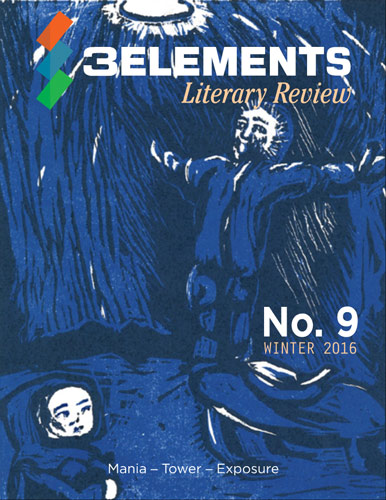3Elements Review – Winter 2016
The idea behind 3Elements Literary Review is a fun one. Each issue, writers are provided with—you guessed it—three elements which they need to incorporate in their piece. Discovering the different (and sometimes similar) ways in which the writers implement the elements is like exploring a treasure map with the three chosen words as a compass. The Winter 2016 issue required writers to get imaginative with the elements ‘mania,’ ‘tower,’ and ‘exposure,’ taking readers on a whirlwind journey through poetry, fiction, nonfiction, photography, and art. The idea behind 3Elements Literary Review is a fun one. Each issue, writers are provided with—you guessed it—three elements which they need to incorporate in their piece. Discovering the different (and sometimes similar) ways in which the writers implement the elements is like exploring a treasure map with the three chosen words as a compass. The Winter 2016 issue required writers to get imaginative with the elements ‘mania,’ ‘tower,’ and ‘exposure,’ taking readers on a whirlwind journey through poetry, fiction, nonfiction, photography, and art.
In “The Backyard Guest,” Michael J. Coene writes from the point of view of the backyard guest, Billy, a mysterious entity that floats in limbo among the other partygoers, to whom he is somehow related. Billy observes the party from the background, seemingly unable to fit in with those around him no matter how much he observes and pretends, while disconnected from himself as well, “By the time I made it back outside, I forgot what it was that had made me cry. I frowned. I thought it was important to remember the things that make you cry.” There’s a fleeting moment of connection with a woman, Gabrielle, as they talk about the pull of the stars. Coene provides a quirkily captivating character while seamlessly working in this issue’s elements.
Laura Boswell in “Swing Shift” and Amber E. Esta in “The Climb” both utilize ‘mania’ in the same way: with characters with bipolar disorder in the throes of their manic episode. Esta’s main character breaks into a factory, sheds her clothes, and dances with danger on the edge of a roof while Boswell’s young narrator watches her father spiral into his own bipolar disorder:
Behind me, my mother sighed and went back into the house. I didn’t understand Daddy’s bipolar disorder then, or why my other seemed put off. His mania was what made him fun! Involved! Exciting! I much preferred it to the other times.
With these two stories, we can see that even when using the elements in similar ways, the context, style, and sheer creativity of the writers makes the similarities something comfortable and familiar rather than heavy-handed.
In poetry, the elements become more prominent as the writers have less room to utilize them. Some work better than others, “A Tadpole with Legs” by Hanna Kuster among my favorites as she talks about that awkward stage of puberty when bodies are suddenly unfamiliar. Using two elements in one line, the alliteration Kuster applies makes the words flow smoothly: “There is a new mania to avoid any exposure, for accidentally / stepping in to see your father slick and soapy in the shower.”
Sprinkled throughout the issue are images, even these applying to the elements, towers appearing often in the form of trees like in Simi Snider’s photography and Barabara Ruth’s technicolor scribbled fire escapes.
3Elements Review is currently accepting submissions for the Summer 2016 issue with the words ‘labyrinth,’ ‘trace,’ and ‘reflex’ for writers looking for a bit of a fun challenge. For readers, I encourage you to pick up the treasure map, check your compass, and begin your adventure through the Winter 2016 issue of 3Elements Review.
[www.3elementsreview.com]





